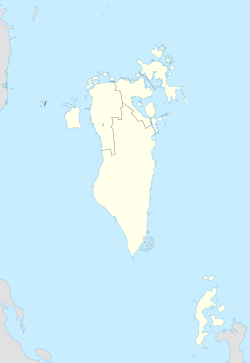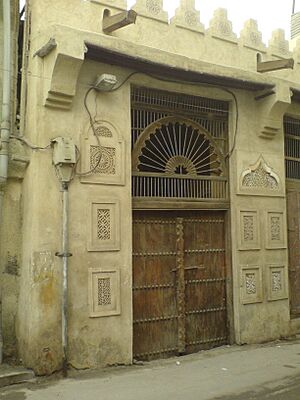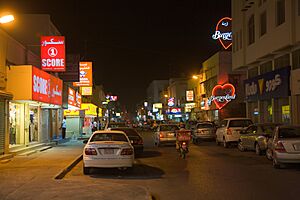Muharraq facts for kids
Quick facts for kids
Muharraq
المحرق
|
||
|---|---|---|

View of Muharraq with the skyline of Manama in the background (2003)
|
||
|
||
| Country | Bahrain | |
| Governorate | Al Muharraq Governorate | |
| Area | ||
| • Total | 57.50 km2 (22.21 sq mi) | |
| Population
(2012)
|
||
| • Total | 176,583 | |
| • Density | 3,291/km2 (8,520/sq mi) | |
Muharraq (pronounced Al-Mu-har-raq) is a major city in Bahrain. It is the third largest city in the country. For a long time, it was the capital of Bahrain until 1932. Then, Manama became the new capital. In 2020, about 263,373 people lived in Muharraq.
The city is found on Muharraq Island. The main airport for Bahrain, Bahrain International Airport, is also on this island. Close to Muharraq are the Amwaj Islands. These are islands made by people, known for their big buildings, hotels, and beaches. Muharraq is also home to Muharraq Club, which is Bahrain's best football team. You can also find the famous Siyadi House here. The city is well-known for its traditional market, called a souq. It is also a place where traditional arts and music are very important. A famous Bahraini singer, Ali Bahar, was from Muharraq.
Contents
History of Muharraq
Muharraq has a very long history. It was once part of an ancient land called Dilmun. Later, it was known as the city of Arwad on the island of Tylos. Some old writers thought this island was where the Phoenician people came from.
After the Persians ruled, Bahrain was controlled by the Greeks. During this time, Muharraq was a center for worshipping a god named Awal, who was like an ox.
By the 5th century AD, Muharraq became a big center for Nestorian Christianity. This type of Christianity was common along the southern coast of the Persian Gulf. The Byzantine Empire often treated Nestorians badly. But Bahrain was outside their control, so it was a safe place for them. Even today, some villages in Muharraq have names that show this Christian past. For example, Al-Dair means 'the monastery', and Qalali means 'monk's cloisters'.
Later, the Portuguese took control of Muharraq in 1521. Then, the Persians took over in 1602. Finally, in 1783, the Āl Khalīfah family gained control of Muharraq and the rest of Bahrain.
Economy and Business
Gulf Air, a large airline, has its main office in Muharraq. Another airline, Bahrain Air, used to have its main office here too.
Education in Muharraq
The Ministry of Education of Bahrain runs public schools in Muharraq.
There are many schools for boys, including:
- Abu Farias Al-Hamdani Primary Boys School
- Al-Maari Primary Boys School
- Hassan bin Thabit Primary Boys School
- Omer bin Abdulazeez Primary Boys School
- Sheikh Mohammed bin Essa al-Khalifa Primary Boys School
- Omer bin Al-Kattab Primary Intermediate Boys School
- Abdul-Rahman Al-Nasser Intermediate Boys School
- Tariq bin Zeyad Intermediate Boys School
- Moharraq Secondary Boys School
There are also many schools for girls, such as:
- A'amena bint Wahab Primary Girls School
- Al-Muharraq Primary Girls School
- Mariam bent Omran Primary Girls School
- Zubaida Primary Girls School
- Istiklal
- Khadija al-Kubra Intermediate Girls School
- Zanoobia Intermediate Girls School
- Muharraq Secondary Girls School
The French School of Bahrain is located in Busaiteen, which is part of Muharraq.
Firjan (Districts) of Muharraq
Firjan is an Arabic word meaning 'districts'. The oldest and largest district in Muharraq is Fareej Al Bin Ali. It was started by the Al Bin Ali tribe in the 1600s. Members of this tribe lived there until recently.
Other districts in Muharraq include:
- Al Bu Khmais
- Al-Gumra
- Al-Zayayina
- Al-Ma'awida
- Bin Ghatim
- Al-Jowder
- Bin Hindi
- Al-'Amamira
- Al-Mahmeed
- Al-Hayaj (or Al-Hayayej)
- Al-Sanqal
- Al-Dosa
- Al-Sagha
- Sheikh Abdullah Sheikh Hamad
- Bin Khatir
Unlike the districts in Manama, most of Muharraq's districts are home to Sunni families.
See also
 In Spanish: Al Muharraq para niños
In Spanish: Al Muharraq para niños






